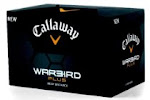The TaylorMade R9 driver featured a 420cc head, three movable weights and a system that allowed golfers to unscrew the clubhead and re-attach it to the shaft in one of eight different positions. Next came the bigger and more powerful R9 460, which also featured the adjustable head but lacked the movable weights.
Players who wanted a TaylorMade driver that combined a 460cc head with three movable weights and an adjustable face were out of luck ... until now. TaylorMade is set to release the R9 SuperTri and R9 SuperTri TP drivers on Feb. 19.
The all-black head of the SuperTri is reminiscent of the r7 SuperQuad, which TaylorMade says was one of its most-popular clubs.
From a performance standpoint, the 460cc head of the SuperTri is more forgiving that the original R9. Because the center of gravity has been moved lower and 2 millimeters back in the head, drives should launch higher with slightly more spin for greater carry distance. In fact, the center of gravity in the SuperTri is even slightly lower and farther back than the R9 460's. The face is also the deepest TaylorMade has ever produced.
According to TaylorMade, the eight different face-angle settings combine with the three adjustable weights (two 1-gram weights and one 16-gram weight) to give the SuperTri up to 75 yards of left-or-right adjustability. In addition, as golfers adjust the face to be more closed, effective loft is added, which increases the launch angle. Adjusting the face to be more open decreases effective loft for a lower trajectory.
The R9 SuperTri will be available in four lofts (8.5°, 9.5°, 10.5°, 11.5°) and come standard with a Fujikura Motore 60-gram shaft in one of five flexes (L, M, R, S, X) for $399. The R9 SuperTri TP features the same head with a choice of 10 premium shafts, including the Aldila Voodoo and Matrix Ozik, for $499.
Article by David Dusek
Golf.com
Thursday, January 21, 2010
How to Beat the Breaks.
This story is for you if...
1. You always read your putts from behind the ball...
2. ...even on severely sloping greens
The Fault
You're missing badly on breaking putts, which leads to fewer birdies and pars and more bogeys. The simple reason for your struggle is poor green-reading technique and alignment.
The Fix
If you want to get a proper read, you need to look at the putt from behind the line you plan to start the ball on, rather than the one that runs directly from the ball to the hole. To do so, pick a spot where you think the apex of the putt (maximum break) will be and examine the putt by looking from behind your ball to that spot. Set the putterhead square to the chosen target line and then walk into your setup, always keeping in mind that your actual target is the apex of the break, not the hole. Stroke the putt to this spot without being distracted by the actual hole. Use this technique consistently, and your green-reading — as well as your results on breaking putts — will improve dramatically.
Align Design
Finding your ball-to-apex line is only half the battle — you must also be able to align your putterface square to it. Any good putter will feature effective aiming lines. If yours doesn't, consider purchasing a new model. I designed a line of Coutour putters with a large arrow on the back end to help you point your putter easily and consistently. For more info, visit coutourgolf.com.
Post by Todd Sones
GolfMagazine.com
1. You always read your putts from behind the ball...
2. ...even on severely sloping greens
The Fault
You're missing badly on breaking putts, which leads to fewer birdies and pars and more bogeys. The simple reason for your struggle is poor green-reading technique and alignment.
The Fix
If you want to get a proper read, you need to look at the putt from behind the line you plan to start the ball on, rather than the one that runs directly from the ball to the hole. To do so, pick a spot where you think the apex of the putt (maximum break) will be and examine the putt by looking from behind your ball to that spot. Set the putterhead square to the chosen target line and then walk into your setup, always keeping in mind that your actual target is the apex of the break, not the hole. Stroke the putt to this spot without being distracted by the actual hole. Use this technique consistently, and your green-reading — as well as your results on breaking putts — will improve dramatically.
Align Design
Finding your ball-to-apex line is only half the battle — you must also be able to align your putterface square to it. Any good putter will feature effective aiming lines. If yours doesn't, consider purchasing a new model. I designed a line of Coutour putters with a large arrow on the back end to help you point your putter easily and consistently. For more info, visit coutourgolf.com.
Post by Todd Sones
GolfMagazine.com
Subscribe to:
Posts (Atom)







